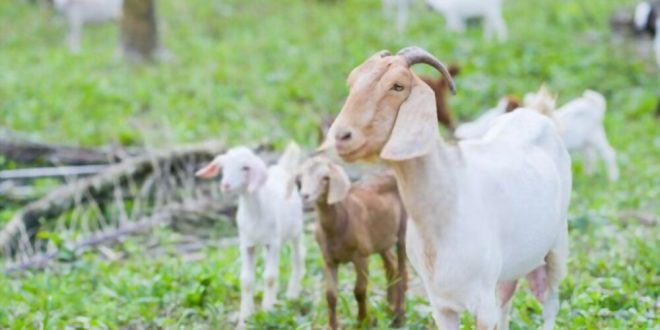Despite its fragile appearance, the goat shows no weakness in the face of adversity. In fact, it is a very resistant animal and well adapted to the most diverse types of environment, from deserts to snowy regions. The mammal’s great tolerance to bad weather facilitates the work of those who start breeding activities, which can be for the production of meat, milk and by-products, products that are gaining more space in Brazilian retail, in addition to the commercialization of breeding stock and breeders. From subsistence family livestock to highly technologized enterprises, there are goat breeding models for every budget. Among the simplest, such as handling a few heads in a small space, the producer can take advantage of the animal’s rusticity to make use of leftover materials on the property in order to set up a shelter. The labor of the relatives themselves is responsible for dealing with the squad.
Nor does the goat require much care or dedication. It does not get sick easily and, therefore, does not demand veterinary practices. As he likes to graze, it is only recommended to carry out deworming and examination of feces. Herbivorous and ruminant, she enjoys eating broadleaf and forage shrub plants such as grasses and legumes, foods that do not weigh heavily on the budget.
Docile and of short stature, as an adult the goat weighs between 45 and 70 kilos. In an average period of nine months of lactation, dairy breeds are able to supply two to five kilograms of milk daily, the most suitable product for the low-cost breeding trade. In dairy goats, the financial return is faster than in the beef. In retail, milk reaches higher prices than cow’s, as it contains more vitamins A, B12, C and D. In addition, goat’s milk is very digestible and suitable for those who are allergic to casein – protein found in cow’s milk.
The goat was one of the first domesticated animals in the world, thousands of years before the Christian era began. Here, it was brought by the colonizers and the squad increased when the immigrants arrived. When interested in acquiring more breeders and breeders, breeders installed in Brazilian territory still resorted to the international market. Europe, North America and Africa were the main suppliers of the new specimens.
Imports still occur, mainly of animals capable of producing meat from the African continent. More than 90% of the goat population in the country is in the Northeast Region, where the canindé, naughty, shared and Black-Back breeds are located.
X-RAY
MINIMUM BREEDING: 25 lactating goats
COST: has a copy from R $ 500
RETURN: after three years
REPRODUCTION: one puppy every 12 months
GET TO WORK
START: When choosing animals for use as breeders or breeders, prefer those that are pure in origin. For dairy or meat-producing goats, be careful if they have good build and plumbness, strong ligaments and bulky udders. The price of animals depends a lot on genetics and physiological status. Pregnant or lactating goats are more expensive. Make the genealogical record of the specimens with entities in the region accredited by the Brazilian Association of Goat Breeders (ABCC).
PURPOSE: Among the breeds there are those with good milk production, such as saanen, alpine and toggenburg, of European origin. There are those with double aptitude, such as the English Anglo-Nubian, and those that yield milk, such as mambrina, jamnapari and bhuj, from Asia. For meat, boer stands out from South Africa.
SYSTEMS: Goats can be bred in three systems. In the extensive, the animals are loose in the pasture. In the semi-intensive, the breeding part of the day begins and then receives supplementation of roughage and concentrate in the trough. In the intensive, goats are kept confined and all food is provided in the trough.
INSTALLATION: The capricious can be made of simple structure, but it is important that it has good conditions to house the animals. If there is an idle installation in place, it can be adapted with room divisions to accommodate the goats, according to the development phase. These options reduce activity costs. It is good that the shelter is comfortable, offers security and protection against wind and rain. Cover the floor with shavings or use 3 cm thick by 5 cm wide battens to make a slatted floor. Leave a space of 2 cm between the battens and 0.5 to 1.8 cm high from the ground.
HYGIENIZATION: It is recommended to keep the caprine always clean to preserve the health of the goats. Daily, remove the waste from the floor and leftover food left in the troughs. At least every 30 days, apply a fire broom or chemical disinfectant to the premises.
FOOD: Plants are the basis of goat meals. The broadleaf shrubs, such as mulberry, ramie and pigeon pea, are well accepted, as are grasses, corn silage and leguminous hay. While forages are good for the digestion of goats, grains are used as a nutritional supplement to favor high production. Mineral salts can be provided in troughs other than food. Keep clean, fresh water available, as goats consume five to six liters a day.
REPRODUCTION: Dairy goats of European origin can breed from four months. There are cases that occur even before this period. However, as they do not yet have adequate development, reproduction among young animals is not indicated. From the first three months of life, raise the goats separated by sex, to avoid early coverages.
